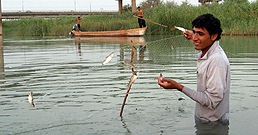The Karun is the largest and the only navigable river in Iran. With a total length of around 900 km, it originates in the Zagros Mountains in western Iran. It then follows a winding course through the province of Khuzestan, passing through several major cities before flowing into the Persian Gulf. Through the years, many large dams have been built on the river or its subsidiaries, mainly to generate hydroelectric power. A considerable part of Khuzestan's resources and transportation is connected in one way or another to the Karun. Since the discovery of oil in the area, the Karun has been an important route for the transport of petroleum to the Persian Gulf, and it remains an important commercial waterway. Moreover, the river’s catchment area covers a huge part of two provinces, providing irrigation to over 69,000 acres of the surrounding plain.
But there are disturbing signs that all these statistics and many other features of the Karun may soon be a thing of the past. In fact the process has already started. There was a time when the name Karun conjured up romantic images of boats gliding over the shimmering reflection of the moon on the soft waves of the river, or gently drifting into the sunset. These images of the Karun were reproduced on ladies’ jewelry, tourist souvenirs and paintings, as well as inspiring popular songs and poems. No trip to Ahvaz or Khorramshahr would have been complete without an excursion on the Karun.
Now, the same name evokes completely different feelings. Articles in the press discuss the prevailing pollution of the river caused by sewage and industrial waste, emphasize the vital need for dredging the Karun, and refer to the diversion of the course of the river as a historical criminal act. Even some of the local authorities strongly criticize the negligence and injustices inflicted on the Karun. One refers to the huge amount of money spent in diverting part of the river to Isfahan and Yazd, adding that now the last of its once full and fast flowing waters are going to be diverted to Qum.
Several other authorities highlight the environmental implications of the pollution. Although heavy fines are being paid to the government by the industries responsible for polluting the Karun, only a fraction of this money is spent on the dredging and maintenance of the river. The pollution and the slime endangering the fish and other species, have destroyed the plants and natural habitat of its wildlife, and have deterred migrant birds from nesting here in recent years.
This multimedia report takes us on a stroll along the banks of the Karun, with a chance to meet local people and share their nostalgia for a past that is in danger of disappearing forever.


